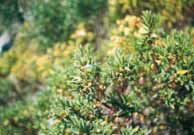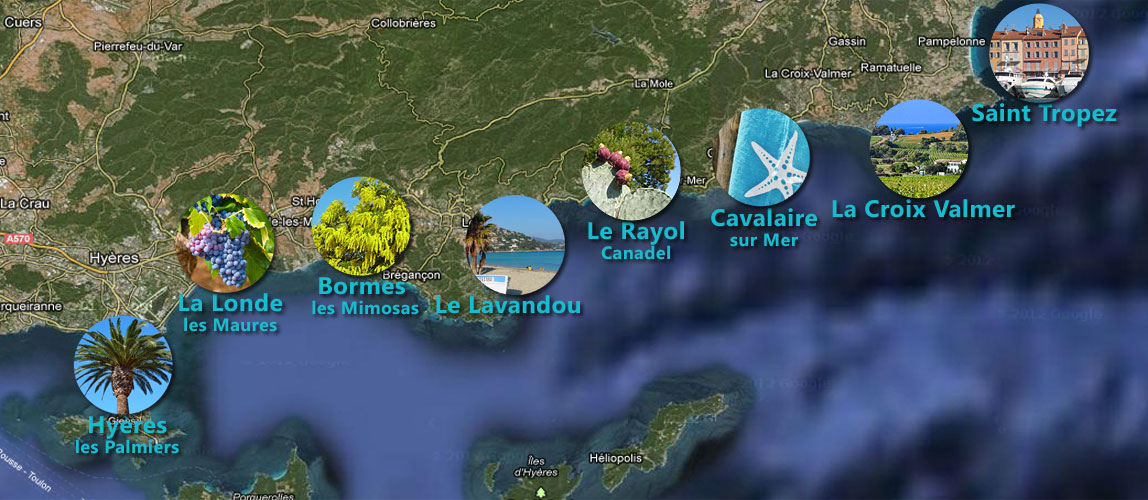Wildlife on the Var coast

Fauna is discrete on the shores; it flees estival heat during the day. Animals called “to cold blood”, are most current like the arthropods (insects, shellfish), reptiles; but marine birds are also observed.
• The Cicada - insect
One finds several species different, but all grow in the same way. The larva of the cicada saw several years under ground. The nymph leaves while digging a hole, seek brushwood to which to clutch itself to metamorphose itself in adult insect. A “very new”
cicada leaves the old envelope (exuviate); it is green pale and vulnerable. It waits without moving the first sunbeams of the summer which harden its cuticle very soft, to be able to take its first take-off. Only the male will be able to sing thanks to its “cymbals” located under its abdomen.
• Thecla - insect (Satyrium sp.)
There are two very similar species in our area: Thecla of the Kermes and that of Yeuse.
One distinguishes them thanks to their red tasks which differ by their number.
 • The Locust with blue wings or blue Oedipode – insect (Oedipoda oerulescens) • The Locust with blue wings or blue Oedipode – insect (Oedipoda oerulescens)
When it is disturbed by a predator, it flies away; the colour sharp blue of its wings becomes visible and fixed then the attention of the prosecutor. On the other hand, when it is posed, the colours of the locust are based in its environment; it “is camouflaged” by homochromy. The predator is disorientated, because it does not see any more a sharp colour. It has cousins with the red wings which use the same principle.
• The Pierid - insect (Pieris sp.)
It belongs to a family of butterflies to the wings yellow white with often one or more black tasks on the former wings. It is a very common kind in Europe. Several generations follow one another of spring the autumn..
• The Lemon of Provence - insect (Gonepterix cleopatra) The male is yellow lemon with an orange task on the former wings.
The female is paler, drawing towards the greenish white, each wing presenting an orange point in its medium. Its caterpillar is in the shrubs of Buckthorns alaternes. This butterfly has one rather long lifespan (a few weeks). The adult is observed
especially in spring and the autumn.
• Scarab of the dunes - insect (Scarabaeus semipunctatus)
One finds it on the sandy shores. It makes balls of excrements before hiding them in the ground; it will lay its eggs there. Thus it fertilizes and airs the ground..
• The Scholium hirsute - insect (Scolia hirta))
This hymenopter lays its eggs in the larvae of the cétoines (of the large coleopters) or of the beetles. The larva of the Scholium will grow at the expense of this alive prey. In spite of its paces of large wasp, it is not dangerous for the man..
• The Ladybird at 7 points - insect (Coccinella 7-punctata)
The animal with good-God, small coleopter is a predator of plant louses. You can make the breeding of it by getting to you larvae in garden-center or agricultural cooperatives..
• Ephippigère or Carries saddle - insect (Ephippiger ephippiger)
Large grasshopper having wings vestigial with variable colouring. The female deposits its eggs in the ground at the time of the laying thanks to a body in the shape of sabre, the oviscapte, located at the end of its abdomen..
 • Zygène - insect (Zygaena sp.) • Zygène - insect (Zygaena sp.)
The colours sharp of Zygènes inform the predatory ones that they are not good to eat; indeed, they can secrete a substance which makes them no edible in the event of alarm. Theys are attracted by the flowers violets.
• The russet-red Squirrel - mammal (Sciurus vulgaris)
In our area, this small mammal is especially pledged with the pine
forests of pines of Alep of which it nibbles the cones (pine cones). It is arboricolous and diurnal. Its body can reach 50 cm length (tail included/understood). It goes down readily from the trees to nourish itself. It leaves us like index of his presence of the apple cores of pine nibbled under the trees.
• The lizard of the walls - reptile (Podarcis muralis)
This small saurien of about fifteen centimetres likes to drive out the small invertebrates. It appreciates the dry and hot places. It can be sometimes in competition with the tarente.
• Tarante - reptile (Tarentola mauritanica)
This gecko is seen (lizard with fingers equipped with suction cups), of robust pace, rather active the night, on the walls, with the mounting of small invertebrates. It has adhesive legs and a vertical pupil. For Provence, the Tarante carries happiness to a house.
• The Black-headed gull - bird (Larus ridibundus)
It is common on our littoral and can, it also, to attend the discharges.
One can especially differentiate it from the seagull by his smaller size. At the period when its bridal plumage is constituted, it is easy to recognize it because its head colours the brown one or of black.
 • The Seagull leucophée - bird lariforme (Larus cachinnans) • The Seagull leucophée - bird lariforme (Larus cachinnans)
This bird, rare fifty years ago, became very common, because it adapted, thanks to its omnivorous mode, with its place appropriateness’s of life. “The gabion” can thus capture sick fish in edge of sea, to eat the fish which the fishermen reject, to steal eggs of other birds, or to settle near our deposits of waste. Days of wind, it seems to play in the draughts. Protected species. 
• The Pink flamingo - bird (Phoenicopterus ruber)
This strange migrating wader excavates the mud with its filter nozzle; it
nourishes small organizations which it can thus catch. Its colour comes to him from a small coloured shellfish of which it
fixes the pigments by absorbing it.
|

|
|
|
|


